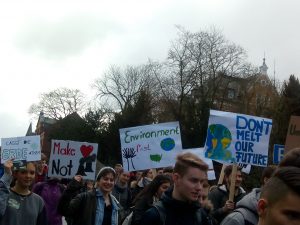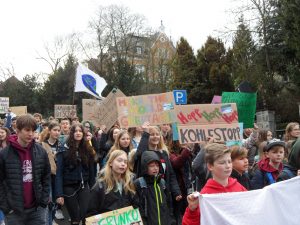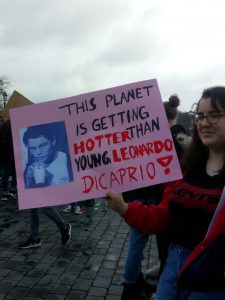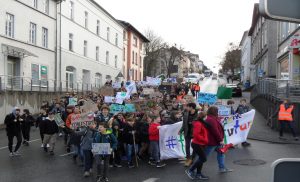Fridays for Future

Having chosen to be an ecologist, I have worked on small projects, and have adopted an eco-friendly lifestyle, and have hoped that I was having an impact however little. Unfortunately, all the good intentions and actions of environmentalists or concerned citizens have not been enough to halt or even slow the degradation of the environment or stop climate change.
Every time ecologists and scientists warn of the condition of the world, it is brushed aside, and business continues as usual. It is a matter of regret and shame for me that young school children have to take to the streets to protect their future. They seem to have understood what politicians and big businesses can’t understand or won’t accept.
A group of students, which included my son, joined the Friday-For-Future demonstrations against climate change in Frankfurt for a few weeks. They then decided it was time to bring the demonstrations to Weilburg, the town the school was situated. I joined the demonstrations to do my bit. Jürgen Becker, my husband decided to pitch in too. He helped by formally applying for permission from the township mayor and the police, the “Ordnungsamt.”
The young demonstrators did the rest themselves. A WhatsApp group was quickly formed among five schools in the city. More than 200 students aged 10 to 18 years took part in the first climate demonstration in Weilburg on 1st March 2019.
Weilburg, in Germany, is a quiet city with just 14,000 inhabitants, and it’s been a very long time since any demonstrations have been held here. So when the preparations started, the local newspaper Mittelhessen announced the planned action to its readers.
 The weather was good, not wet or windy. Before 10 am, the students from schools began gathering together. The police were there with two cars and six staff. At their request, seven students who were over 18 years old were asked to take on the role of monitoring the group. They put on their orange vests and listened nervously to the instructions given by the police. Keep your friends to one side of the road they were told; make place for traffic on the main road.
The weather was good, not wet or windy. Before 10 am, the students from schools began gathering together. The police were there with two cars and six staff. At their request, seven students who were over 18 years old were asked to take on the role of monitoring the group. They put on their orange vests and listened nervously to the instructions given by the police. Keep your friends to one side of the road they were told; make place for traffic on the main road.
The younger demonstrations in the meanwhile lined up in front, holding up the big banner eager to start. Only caps were visible from a couple of the youngest behind the banner. We are here to demonstrate, let’s start they stomped impatiently, while the group waited for all to assemble.
Then they started to move, shouting slogans and waving their – mostly – handmade banners. A police car escorted them in front, and one was behind, and many officers were on foot. The police took good care of the young demonstrators, clearing the traffic, and standing guard at crossroads. The group wound its way through the residential areas, and after half a kilometer, a second group joined them. Then they went down the main road.
The lanes in Weilburg rang to slogans such as:
- “What do we want? Climate Justice. When do we want it? Now”
- “Wir sind hier, wir sind laut, weil man uns die Zukunft klaut” (We are here, we are loud because you are robbing our future)
- “Hopp, Hopp, Hopp, Kohle stopp” (Hop to it, Stop Coal)
It was clear the students were engaged and had informed themselves of the environmental problems and their causes. They were also very aware of the consequences. The group had many creative banners to show this:
- Planet before Profit

- Don’t Melt our Planet
- There is No Planet B
- The Planet needs Trump care
- Make our world great again
- “Umweltschutz statt Umweltschmutz” (Save the environment instead of exploiting it)
- “Grünkohl statt Braunkohle” (Green fuel instead of coal)
- “Badehose raus, das Meer kommt” (Bring out your swimwear, the sea is coming)
- “Lasst die Erde atmen” (Let the earth breathe)
There were some light-hearted takes as well:
- The Planet is getting hotter than young Leonardo DiCaprio
- “Man serviert Bier nicht warm” (You don’t serve beer warm)
 The Education Ministry and schools have taken a dim view of the students’ strikes for climate or “Klimastreik.” At the behest of the ministry, schools are warning students from skipping classes. Missed classes will be entered into the report card of students. Some schools are going further and have levied a fine as a penalty, prompting a petition that is gaining wide support. Some schools are more understanding, and have agreed to mention that the absence is due to participation in ‘Fridays For Future.’
The Education Ministry and schools have taken a dim view of the students’ strikes for climate or “Klimastreik.” At the behest of the ministry, schools are warning students from skipping classes. Missed classes will be entered into the report card of students. Some schools are going further and have levied a fine as a penalty, prompting a petition that is gaining wide support. Some schools are more understanding, and have agreed to mention that the absence is due to participation in ‘Fridays For Future.’
The group took on the increasing criticism from conservative quarters for the Friday Demonstrations with many placards:
- “Wir lernen nicht für eine zerstörte Zukunft” (We aren’t studying for a destroyed future)
- “Mit Fehlstunden können wir leben, mit Klimawandel nicht” (We can live with missed classes, but not Climate Change)
- “Wir retten die Welt” (We are saving the world)
- “Für unsere Zukunft” (For Our Future)
The reaction by all – politicians, the public, and schools has been only about the timing of the strikes. They want children to strike after school hours. What are missing are proposals for concrete action by the government: Proposals to tackle climate change, and to meet targets they accepted in the Paris Agreement 2015. This is in spite of Chancellor Angela Merkel coming out in support of the student strikes.
People insist student should be attending classes to study. Schools, education experts, and parents know that there are many kinds of learning, and the theoretical approach is only one of them. It is for this reason that schools include sports, music, theatre, art, excursions, etc., as part of the curriculum.
The students on their Friday for Future demonstrations two weeks ago showed what they are learning from the climate strike:
- Event Planning: Organising and coordinating an event with five schools and 200 people is no mean feat.
- Assuming responsibility for their actions: The missed classes marked in the report could well affect the chances of the older students to get into a university or course of their choice in a year or two.
- Self-discipline: Even though the students broke school rules to stay away from classes, they conducted themselves responsibly and obeyed instructions given to them by the police.
- Mutual respect: Regardless of their age, all demonstrators got along well with each other, in sharp contrast to the culture of bullying younger children that can occur at school.
- Becoming proactive: The students have shown that they can take the initiative, and look for solutions instead of whining and waiting for other people to solve their problems.
- To go outside: People who complain that children spend all their time in front of computers or mobile phone will be happy to know that the children were out doing something together in the open.
- Cleaning up after them: Instructions given by officers of the law are harder to ignore than those from parents!
- Thinking for themselves: Last but not least, the students are beginning to take stock of facts, thinking about it, and coming to their own decisions.
I was very proud of my child that day; any parent would feel the same about their children if they had been there.
The match ended in the City Square where the students called on the government to discuss their demands and make the necessary changes to protect the environment. So far none of the governments in the world have taken the young protestors seriously.
To the young people, I can only say, we hear you. We are with you in your struggle. We support your demonstrations and will work harder to tackle climate change.


